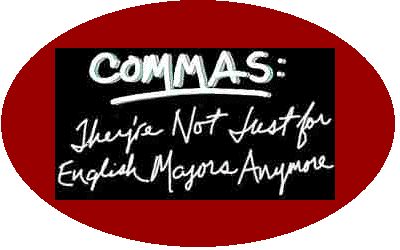 |
commas
with... |
Non-Restrictive
Elements
|
By
non-restrictive
element I mean items such as transitional words, direct address, appositives, or others that you could take out without changing a sentence's meaning.
You're
probably
already familiar with such elements, sometimes called "non-essential"
elements. Again, for our purposes, an "NRE" is any element
that is unessential to the basic meaning of the sentence.
What
you might now have realized before is that non-restrictive elements are a lot like
introductory elements--they add extra information--but they come in the middle or at
the end of a sentence rather than at the beginning. Also like introductory elements, they can be a single word, like a transition.
The
problem with the furniture, however, is that it's
on fire.
Here,
the word however acts as a non-restrictive element. The term non-restrictive refers to
elements that do not "restrict" the meaning of the sentence. More specifically, they
generally do not change the meaning of the subject:
The
poem, written in some language I couldn't understand, made me want to
throw my book away.
As
with introductory elements,
the trick to recognizing non-restrictive elements is to find the
sentence's main idea. In this case, it's
The
poem... made me want to throw my book away.
The phrase Written
in a language I couldn't understand is a non-restrictive element because it
merely gives us more information without "restricting" the meaning of the sentence's
subject, poem.
Q. How
can I tell whether an element is restrictive or non-restrictive?
A.
Good question.
Here's an opportunity to see how commas can be used to help your reader
understand your meaning. Restrictive elements, as you've
probably guessed by now, restrict the meaning of a sentence. Consider
how the presence of commas can change the meaning of a sentence.
Boneheads who don't shower often have few friends.
Ask
yourself about the meaning
of this sentence. As the sentence is punctuated now, which
boneheads have few friends?
The
ones who don't shower. The clause isn't set off with commas;
that means
it restricts the meaning of Boneheads to ONLY those who don't
shower.
Now
see what happens
if commas are placed around the clause. What does this sentence mean?
Which
boneheads have few friends?
Boneheads,
who don't shower, often have few friends.
This
sentence proclaims that ALL boneheads have few
friends (it also implies that none
of them showers, a grim thought indeed). In other words,
placing commas
around the clause who don't shower makes it non-restrictive.
That means it doesn't restrict the meaning of the subject, Boneheads.
The fact that they don't shower is just extra information.
Here's
another example:
Presidents,
who
drive drunk, should never be re-elected.
Which
presidents does this sentence
say should never be re-elected? All of them. The
commas mean that
the clause who drive drunk is non-essential information and that it
does
not restrict your re-election policy.
Again,
if we remove
the commas, we restrict the meaning of Presidents to ONLY those who
drive drunk.
Presidents who drive drunk should never be re-elected.
Intro, Get Started, IE, CE,
2IC, FANBOYS,
CA, NRE,
Review
|